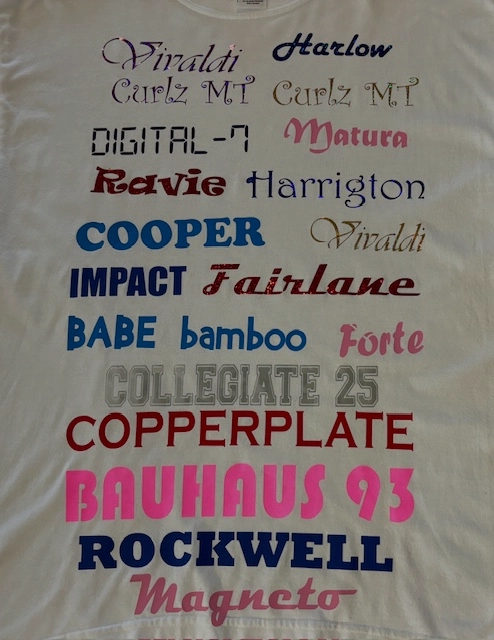The Art of Custom-made Needlework: Opening the Keys to Creating Distinct and Remarkable Designs
Embroidery, a craft steeped in tradition and creativity, holds within its complex stitches the power to change textile right into a canvas of unique expression. The secrets to producing personalized needlework layouts that astound the eye and leave a lasting impression lie in a delicate equilibrium of strategy, imagination, and focus to information. As we dive right into the globe of personalized needlework, we reveal the nuanced interaction in between thread selection, stitch complexity, and layout personalization that elevates a plain garment to an artwork. Join us on a trip via the art of personalized needlework as we unwind the mysteries behind crafting genuinely extraordinary and unique creations.
Selecting the Right Embroidery Threads
When selecting needlework threads, what crucial elements should you think about to make sure the most effective outcomes for your customized layouts? The option of embroidery string is essential in identifying the final result of your stitched layout. One of the primary considerations is the product of the thread. Different products such as cotton, polyester, rayon, and silk supply differing levels of luster, resilience, and structure. It is important to select a string material that matches the textile you are stitching on and straightens with the preferred appearance of the design.
Thicker strings can add dimension and appearance to your layout, while finer strings are suitable for complex details and tiny text. In addition, considering the shade fastness and washability of the thread is essential to make certain that your custom-made designs keep their quality and vibrancy over time.
Discovering Different Stitch Methods
To look into the realm of 'Discovering Various Stitch Strategies', one have to understand the intricacies and subtleties that each stitching method gives the art of needlework. Different stitch techniques not only include aesthetic interest but likewise contribute to the overall texture and measurement of the style. One preferred stitch strategy is the satin stitch, which involves closely jam-packed parallel stitches to develop a smooth and shiny surface, suitable for filling out forms and producing vibrant details.
On the other hand, the backstitch is a flexible strategy commonly utilized for outlining and adding great details. It includes stitching backward to produce a solid line of needlework. Additionally, the French knot stitch includes a responsive aspect to styles, perfect for developing textured accents like blossom centers or attractive touches.
Discovering different stitch techniques enables embroiderers to have fun with light, shadow, and depth within their styles, boosting the visual charm and imaginative high quality of their needlework tasks. By understanding numerous stitching approaches, one can open endless opportunities for producing unique and memorable customized embroidery pieces.
Incorporating Personalized Style Components
Having actually checked out the ins and outs of different stitch methods such as the satin stitch, backstitch, and French knot, the emphasis currently changes towards incorporating personalized layout components in custom embroidery useful link projects. Individualized style aspects play an essential role in making embroidery projects genuinely distinct and memorable.
One more means to integrate personalized design aspects is by including signs or motifs that hold special meaning to the recipient or mirror their rate of interests and personality. Integrating a favored flower, pet, or hobby-related icon can make the embroidery layout much more purposeful and customized. Furthermore, picking colors that reverberate with the recipient or line up with the desired theme can even more boost the customization of the needlework job.
Mastering the Art of Shade Coordination

One trick aspect of shade coordination is understanding shade theory. This consists of knowing exactly how various colors connect with each various other, the emotions they share, and how they can tailor seamstress be incorporated to create visually attractive layouts. By applying shade concept principles, embroiderers can produce unified color schemes that improve the overall look of the layout.
Additionally, focusing on contrast is essential in shade sychronisation. Utilizing contrasting colors can aid particular aspects of the layout pop, boost legibility, and produce an aesthetically vibrant embroidery piece. By mastering the art of shade sychronisation, embroiderers can raise their layouts and develop memorable pieces that resonate with customers and visitors alike.
Enhancing Appearance With Advanced Embroidery Stitches
French knots, as an example, are ideal for adding little, elevated dots to your layout, simulating the appearance of beads or producing a textured surface. Bullion knots, on the other hand, can be utilized to produce twisted, ropelike components that include an elegant feeling to the needlework. Seed stitching involves little, scattered stitches that can complete locations with a multicolor structure, while turkey job produces cosy, dimensional accents similar to pet hair or vegetation. Trying out these sophisticated embroidery stitches enables you to push the boundaries of conventional needlework and develop absolutely one-of-a-kind and aesthetically attractive structures in your styles.
Verdict
Finally, the art of custom-made needlework includes suit tailor near me a combination of picking the ideal threads, exploring various stitch methods, integrating personalized layout aspects, mastering color sychronisation, and boosting appearance with advanced stitches. By understanding and carrying out these crucial elements, embroiderers can produce unique and remarkable designs that showcase their creative thinking and skill. Needlework lovers can open the tricks to developing attractive and custom items that stick out and leave a long lasting impact.